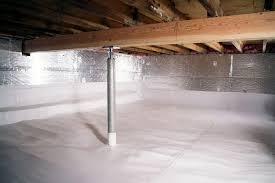Crawl Space Encapsulation Tips to Keep Your Home Safe and Dry

When it comes to protecting your home from moisture, mold, and structural damage, few upgrades are as effective as crawl space encapsulation. This process involves sealing off the crawl space beneath your house to prevent dampness, pests, and other unwanted issues from affecting your living environment.
For homeowners concerned about air quality, energy efficiency, and long-term durability, encapsulating your crawl space is a smart investment. This guide offers practical tips and insights to help you get started—whether you're doing it yourself or hiring a professional.
What Is Crawl Space Encapsulation?
Crawl space encapsulation is the process of sealing your crawl space from outside elements using a vapor barrier, insulation, and air sealing techniques. For homeowners in Champaign, IL, where humidity and seasonal moisture are common, this method is especially important. The goal is to control dampness, reduce humidity, and protect the structure of your home.
A properly sealed crawl space creates a dry, clean environment that improves indoor air quality and supports your home’s energy efficiency. It typically includes:
-
A durable crawl space liner
-
Vapor barrier installation on the floor and walls
-
Sealing of vents and gaps
-
Optional insulation and dehumidification systems
Why Encapsulation Matters for Homeowners
In climates like Champaign, IL, where temperature swings and humidity can cause condensation under homes, encapsulation becomes more than a luxury—it’s a necessity.
Without proper sealing, your crawl space can collect moisture, which leads to:
-
Mold and mildew growth
-
Wood rot and foundation weakening
-
Pest infestations
-
High indoor humidity
-
Poor air quality in living areas
Encapsulation helps eliminate these risks, keeping your home healthier, dryer, and more comfortable all year round.
Step-by-Step Crawl Space Encapsulation Tips
Whether you plan to hire experts or explore DIY crawl space sealing, here’s a breakdown of the key steps involved:
1. Inspect and Clean the Crawl Space
Before beginning any work, remove debris, old insulation, or signs of water damage. A clear workspace ensures better sealing and barrier application.
2. Install a Quality Vapor Barrier
Use high-quality plastic sheeting for the crawl space, ideally 12–20 mil thick. This barrier lines the floor and walls, keeping moisture out.
-
Overlap seams by at least 12 inches
-
Secure the barrier with foundation tape or sealing adhesive
-
Extend it up the walls and secure it with fasteners
This layer is the core of your crawl space encapsulation system.
3. Seal Air Leaks and Vents
Use spray foam or caulk to seal any gaps around pipes, vents, and electrical lines. Close and seal off crawl space vents unless required for ventilation by local codes.
4. Consider Insulating Crawl Space Walls
Depending on your region and home structure, adding rigid foam or spray insulation to crawl space walls can improve energy efficiency.
5. Install a Dehumidifier (Optional but Recommended)
To maintain low humidity, especially in high-moisture regions, a dehumidifier is often added after the encapsulation system is complete.
DIY vs. Professional Encapsulation
While DIY crawl space sealing can be a cost-effective option for handy homeowners, it’s a time-consuming and labor-intensive project. Crawl spaces can be tight, dirty, and challenging to work in—especially if there's water damage or structural concerns.
Benefits of hiring professional encapsulation services include:
-
Accurate moisture and mold assessment
-
Safe material handling
-
Proper sealing and vapor barrier installation
-
Warranty-backed work
Working with trusted professionals, such as Payless Insulation, ensures long-lasting protection and code-compliant results.
Understanding Crawl Space Encapsulation Cost
The crawl space encapsulation cost can vary depending on size, condition, and complexity. On average, homeowners can expect:
-
DIY projects: $1,000–$2,500 (materials only)
-
Professional installation: $3,000–$10,000+ depending on size, drainage systems, and upgrades like insulation or dehumidifiers
While the upfront cost may seem high, the return on investment includes:
-
Lower energy bills
-
Less frequent repairs
-
Higher home resale value
-
Healthier living environment
Common Mistakes to Avoid
When working on your crawl space, steer clear of these errors:
-
Using too-thin plastic sheets that tear easily
-
Not sealing overlaps and wall edges properly
-
Ignoring existing moisture or pest problems
-
Skipping vent sealing or dehumidification
-
Installing materials directly over wet soil
A rushed or incomplete job can lead to trapped moisture, mold regrowth, or even structural damage.
Final Thoughts
Crawl space encapsulation is one of the best things you can do to protect your home's foundation, improve indoor air quality, and reduce utility costs. Whether you're sealing it yourself or hiring a team of experts, the key is using high-quality materials, following proper steps, and addressing moisture before it becomes a bigger issue.
For homeowners looking to upgrade their insulation and moisture protection, working with a trusted company like Payless Insulation offers peace of mind and long-lasting results.
Frequently Asked Questions
Q1: How long does crawl space encapsulation last?
A: When installed properly, vapor barriers and encapsulation systems can last 20 years or more with minimal maintenance.
Q2: Will sealing my crawl space help lower energy bills?
A: Yes, it reduces air leaks and improves insulation performance, making your heating and cooling systems more efficient.
Q3: Is encapsulation safe for older homes?
A: Absolutely. In fact, older homes often benefit the most due to their lack of modern moisture barriers and insulation.
Q4: Do I still need a dehumidifier after encapsulation?
A: While not always required, a dehumidifier helps maintain ideal humidity levels and protects your investment long-term.
Q5: Can I encapsulate the crawl space myself?
A: DIY is possible for small, dry spaces, but professional work is recommended for larger or high-moisture areas.
- AI
- Vitamins
- Health
- Admin/office jobs
- News
- Art
- Causes
- Crafts
- Dance
- Drinks
- Film
- Fitness
- Food
- Juegos
- Gardening
- Health
- Home
- Literature
- Music
- Networking
- Other
- Party
- Religion
- Shopping
- Sports
- Theater
- Wellness


